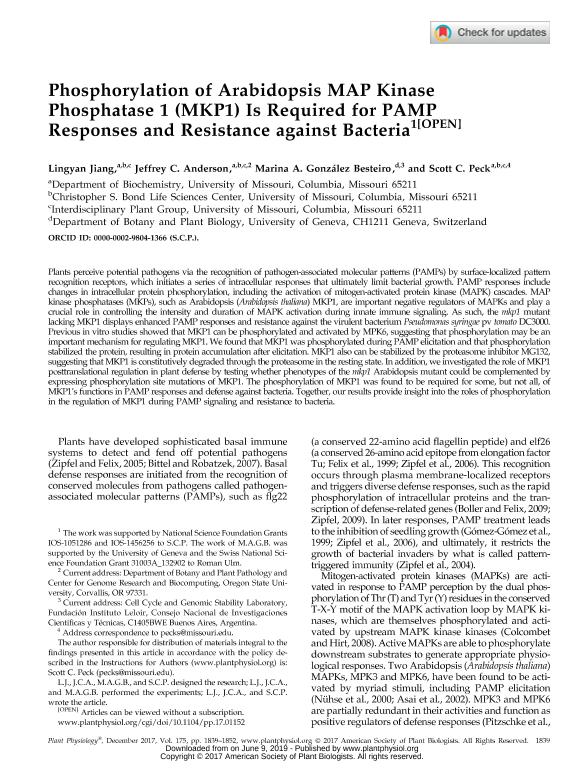Mostrar el registro sencillo del ítem
dc.contributor.author
Jiang, Lingyan
dc.contributor.author
Anderson, Jeffrey C.
dc.contributor.author
González, Marina Alejandra

dc.contributor.author
Peck, Scott C.
dc.date.available
2019-10-16T21:17:58Z
dc.date.issued
2017-12
dc.identifier.citation
Jiang, Lingyan; Anderson, Jeffrey C.; González, Marina Alejandra; Peck, Scott C.; Phosphorylation of arabidopsis MAP kinase phosphatase 1 (MKP1) is required for PAMP responses and resistance against bacteria; American Society of Plant Biologist; Plant Physiology; 175; 4; 12-2017; 1839-1852
dc.identifier.issn
0032-0889
dc.identifier.uri
http://hdl.handle.net/11336/86110
dc.description.abstract
Plants perceive potential pathogens via the recognition of pathogen-associated molecular patterns (PAMPs) by surface-localized pattern recognition receptors, which initiates a series of intracellular responses that ultimately limit bacterial growth. PAMP responses include changes in intracellular protein phosphorylation, including the activation of mitogen-activated protein kinase (MAPK) cascades. MAP kinase phosphatases (MKPs), such as Arabidopsis (Arabidopsis thaliana) MKP1, are important negative regulators of MAPKs and play a crucial role in controlling the intensity and duration of MAPK activation during innate immune signaling. As such, the mkp1 mutant lacking MKP1 displays enhanced PAMP responses and resistance against the virulent bacterium Pseudomonas syringae pv tomato DC3000. Previous in vitro studies showed that MKP1 can be phosphorylated and activated by MPK6, suggesting that phosphorylation may be an importantmechanism for regulatingMKP1. We found that MKP1 was phosphorylated during PAMP elicitation and that phosphorylation stabilized the protein, resulting in protein accumulation after elicitation. MKP1 also can be stabilized by the proteasome inhibitor MG132, suggesting thatMKP1 is constitutively degraded through the proteasome in the resting state. In addition,we investigated the role of MKP1 posttranslational regulation in plant defense by testing whether phenotypes of the mkp1 Arabidopsis mutant could be complemented by expressing phosphorylation site mutations of MKP1. The phosphorylation of MKP1 was found to be required for some, but not all, of MKP1’s functions in PAMP responses and defense against bacteria. Together, our results provide insight into the roles of phosphorylation in the regulation of MKP1 during PAMP signaling and resistance to bacteria.
dc.format
application/pdf
dc.language.iso
eng
dc.publisher
American Society of Plant Biologist

dc.rights
info:eu-repo/semantics/openAccess
dc.rights.uri
https://creativecommons.org/licenses/by-nc-sa/2.5/ar/
dc.subject
MAP KINASE PHOSPHATASE
dc.subject
PAMP RESPONSES
dc.subject
PHOSPHORYLATION
dc.subject
ARABIDOPSIS
dc.subject.classification
Ciencias de las Plantas, Botánica

dc.subject.classification
Ciencias Biológicas

dc.subject.classification
CIENCIAS NATURALES Y EXACTAS

dc.title
Phosphorylation of arabidopsis MAP kinase phosphatase 1 (MKP1) is required for PAMP responses and resistance against bacteria
dc.type
info:eu-repo/semantics/article
dc.type
info:ar-repo/semantics/artículo
dc.type
info:eu-repo/semantics/publishedVersion
dc.date.updated
2019-10-02T14:26:39Z
dc.journal.volume
175
dc.journal.number
4
dc.journal.pagination
1839-1852
dc.journal.pais
Estados Unidos

dc.journal.ciudad
Rockville
dc.description.fil
Fil: Jiang, Lingyan. University of Missouri; Estados Unidos
dc.description.fil
Fil: Anderson, Jeffrey C.. University of Missouri; Estados Unidos
dc.description.fil
Fil: González, Marina Alejandra. University of Missouri; Estados Unidos. Consejo Nacional de Investigaciones Científicas y Técnicas; Argentina
dc.description.fil
Fil: Peck, Scott C.. Universidad de Ginebra; Suiza
dc.journal.title
Plant Physiology

dc.relation.alternativeid
info:eu-repo/semantics/altIdentifier/url/http://www.plantphysiol.org/content/plantphysiol/175/4/1839.full.pdf
dc.relation.alternativeid
info:eu-repo/semantics/altIdentifier/doi/http://dx.doi.org/10.1104/pp.17.01152
Archivos asociados
